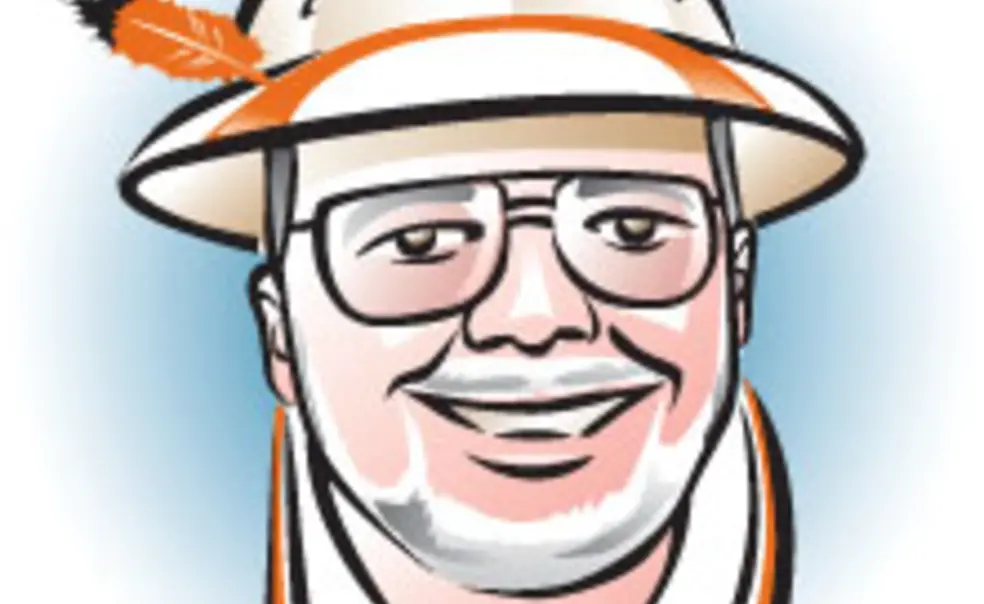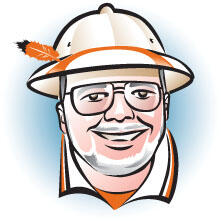- Ambassador Alexei de Sadesky, Dr. Strangelove
Every era in a small community like Princeton has its common historical touchpoints, relatively universal experiences that offer at least an illusion of shared consciousness and interests. In the modern age of specialized academic fields, one-sport athletes, fragmented colleges, Greeks and clubs, and thousands of Facebook groups, this is a tough go, to understate the obvious. But back in the ’20s there was the football Team of Destiny, the Four-Course Plan, and the hated Car Rule, followed by the astonishing football teams of Fritz Crisler in the 1930s (with the Tiger-striped helmets that have returned today), along with miler Bill Bonthron ’34 and the Veterans of Future Wars, sort of a dry run for Stephen Colbert. World War II and Korea provided enforced communal associations, then Charlie Caldwell’s masterful football teams, Albert Einstein’s bicycle, and Tiger Band’s new plaid blazers galvanized cheerier interests in the ’50s. In the ’60s, Bill Bradley and coeducation provided overwhelming day-to-day discussion points across campus. By the 1970s, with the undergraduate body beginning to expand and specialize, such broadly popular fixations became harder to find. Football attendance fell off a cliff, fewer clubs bickered, and pink Princeton sweatshirts appeared in the U-Store.
And then, in from the Wild West swooped the A-Bomb Kid. Nobody around at the time will ever forget him. The perfect poster wonk for the Cold War, he brought out the combined confusion and frustration of the post-Vietnam era via the bold and breathtakingly insightful act of … submitting his term paper.
Of late I’ve found the terror of the Cold War difficult to explain to those beneath the delicate age of, oh, maybe 25. There are multiple contributing pieces to the challenge: The current Russia is such a drab mess; exposure of even great powers today to fright from insipid, addled terrorists – internal and external – is so immediate as to co-opt the discussion; the clarity of Civil War or World War II issues is impossible to match. When the Cold War began with the U.S. response to Soviet expansionism in the 1940s, terror was hardly the intent. George F. Kennan ’25, who first laid out the concept of containment in a series of papers beginning with his posting in Moscow, had in mind approaches like the Marshall Plan, of which he became a prime architect. Of course, in practice the confrontation at the edges of the two spheres of influence almost immediately began an arms race (exacerbated by Korea and the newfound nuclear weapons), which then went careening out on its own seemingly inevitable path. The nadir of the era, from the Bay of Pigs to the Cuban Missile Crisis to Vietnam to Afghanistan, left a particularly grim taste in international affairs, to the degree that even Richard Nixon’s overtures to communist China had to be carried out in secret for an extended period. And by grim taste, I mean Grimm taste – my favorite movie to this day is Stanley Kubrick ’s jarring 1964 Dr. Strangelove, which aside from some of the great acting in Hollywood annals (Sterling Hayden unretired just for his role, Peter Sellers played three major parts) has quotable dialogue and Dickensian names (Hayden is Gen. Jack D. Ripper, Sellers’ U.S. president is Merkin Muffley) on virtually every page, thanks to Kubrick and the über-satirist Terry Southern. Their view of the insanity of the arms race (“You can’t fight in here: This is the War Room!”) culminates in the creation of a weapon whose only function is to obliterate the entire planet, explained by the Soviet ambassador as a cost-saving alternative so his citizenry won’t revolt over scarcity of nylons. Aside from being the ultimate in black humor, this whacko concept seemed mainstream enough to the nice folks at Columbia Pictures – consider, they also made A Man for All Seasons around the same time – to get major studio funding and distribution.
Enter John Aristotle Phillips ’78, a transfer physics/engineering student from the University of California at Berkeley who had something in common with whoever at the studio greenlighted the movie – he was an independent thinker. He rode a motorcycle from Berkeley to Princeton. He got to be the Tiger at football games by the clever conceit of being the only volunteer. He revived the Student Pizza Agency, redubbed Aristotle Pizza, and his 14 staffers called him “Shroom” in honor of both his research and his pies. And when intermittently motivated – he had no idea what his grade-point average was, but knew he needed a good mark in Harold Feiveson *63 *72 and Freeman Dyson’s disarmament and arms control seminar – he had a fresh outlook on his studies, too. Suspecting the “arms control” part of the class was not very promising, he set out to find whatever he could in the public domain related to building an atom bomb. Adding a cagey guess about the configuration of the trigger, he was able to locate specs for everything else of consequence he needed, and turned in the resulting opus on How to Build a Nuke for $2,000 to the enthusiastic Dyson, a world-renowned physicist from the Institute for Advanced Study and freethinker in his own right (just consider the Dyson sphere). Phillips got a redemptive “A” in the course and a firestorm of frantic attention from a public that finally figured out there were really no nuclear secrets left. Never mind that luminaries such as Einstein and Oppenheimer had said as much in the ’40s; somehow in 1977 it stuck.
The timing couldn’t have been better/worse. India had announced publicly its nuclear capability only two years before, and China was holding atmospheric tests of its weaponry. So learning that your random college mascot was only 15 pounds of plutonium shy of blowing up a city didn’t go over well at all – except perhaps with the French and the Pakistanis, who gave Phillips a call and asked for a copy of his paper, which he politely refused. Dyson and Phillips, reasoning that the conclusion (that there were really no secrets) required publicity itself to make its point, gladly went to the press with all of this, showing the same aplomb that got the sphere and the pizza agency their snappy monikers. Whatever lingering doubt might have arisen about Princeton’s place in the physics firmament since Einstein’s death was erased, Phillips co-wrote a book that would become a made-for-TV screenplay, and the whole campus had plenty to talk about for months as arguments erupted over whether the model really would work and who was guarding the world’s plutonium, or at least the portion that governments knew about. Thus the A-Bomb Kid became a watchword for ’70s Princetonians as well as humanity’s newest iteration of Pandora’s box. And you could hear the clang as reinforced phalanxes of security guards reported to every nuclear-breeder reactor on the planet.
Although in retrospect he could have stayed with Aristotle Pizza and become Herman Cain, Phillips ended up taking a more circuitous route into politics. After his inevitable book Mushroom was published, he ran twice unsuccessfully for Congress. Observing that the infrastructure of electioneering was stuck somewhere in the era of Millard Fillmore, he flipped to the supply side as a pioneer in political-technology field, feeding data in endless permutations to campaigners and officeholders of all stripes, not only up to the White House but around the world. The thriving hi-tech company he and his brother founded to do this is named, of course, Aristotle.
Freeman Dyson continues at 87 to be one of the most refreshing thinkers around, having addressed everything from quantum physics to space travel to nuclear policy to global warming to the mind of God, and continues to collect global prizes not only in energy (the Enrico Fermi Award) but in writing (the Lewis Thomas Prize) and religion (the Templeton Prize). Having lived in Princeton for 58 years, he certainly qualifies for the prestigious list of local luminaries who were passed over for the Nobel physics prize, including John Wheeler and Bob Dicke ’39.
So on reflection, it’s hard to imagine a more fortuitous combination of insightful personalities to meld the two great curses of the Cold War – byzantine politics and the fear of Armageddon – and when a dose of reality was needed most, come up with the cheerfully upbeat black comedy of the A-Bomb Kid. They certainly understood what Stanley Kubrick did, that people cannot learn without pain. Of course, that observation first was made by Aristotle.














No responses yet